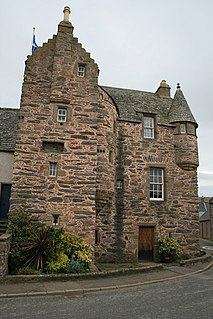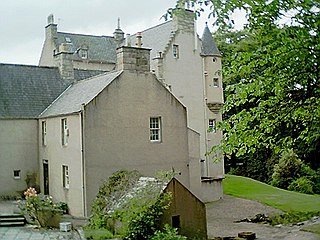
Balfluig Castle is an L-plan tower house, dating from the mid-16th century, a mile south of Alford, in the Howe of Alford, Aberdeenshire, Scotland. [1] The tower is conspicuous throughout the Howe. [1] It may be viewed by appointment. [2]

Balfluig Castle is an L-plan tower house, dating from the mid-16th century, a mile south of Alford, in the Howe of Alford, Aberdeenshire, Scotland. [1] The tower is conspicuous throughout the Howe. [1] It may be viewed by appointment. [2]
The first owners of Balfluig were a branch of Clan Forbes. [1] The voussoirs on the doorway show the date 1556. [3] The castle was burned during the battle of Alford in 1645. [1] It was purchased by the Farquharson of Haughton in 1753. In due course it was used as a farmhouse. It was derelict by the 1960s, but a new owner, Mark Tennant, restored it, as one of the earliest fortalices saved through the help of the Historic Buildings Council for Scotland, particularly through the advocacy of W. Douglas Simpson. [1]
The date of building is significant as it is in a period where there was little private building in Scotland. [1]
The plan of the castle is highly unusual. [1] The main block of the castle has three storeys and a garret. [1] The wing, one storey higher, and topped by a watchtower, projects eastward from the main block in a way that creates two re-entrant angles. [1] A semicircular stair tower rises in the south-west angle. [1]
The outer angles are corbelled square beneath roof level, being rounded lower. The walls have many gun loops. On the south gable is a massive chimney stack. [1]
A courtyard leads to the entrance, an arched doorway protected by gun loops, which is in the main re-entrant angle. [1]
The basement of the main block contains two vaulted chambers, the kitchen and the wine cellar. There is a private stair to the hall above, which has a vaulted withdrawing room attached. [1]
In the basement of the wing is a vaulted guardroom, which has a small prison beneath the turnpike stair. [1]
The tower is roughly built of pinned boulder rubble; the dressings are part sandstone and part granite. [3]
The open timbered roof probably dates from the restoration of the castle after the battle of Alford. [1]
It is a category A listed building. [3]
Tradition asserts that there was another fortalice nearby. The rival lairds would shoot at each other from their watch rooms. After one finally killed the other, the surviving laird was filled with remorse. [1]
| Wikimedia Commons has media related to Balfluig Castle . |

Colliston Castle is a 16th-century Z-plan tower house, altered and extended in the 18th and 19th centuries. It is located 6 kilometres (3.7 mi) north of Arbroath, in Angus, Scotland, and remains occupied.

Muness Castle is located on Unst, which is one of the Shetland Islands of Scotland. The castle is 3 kilometres (1.9 mi) east of the village of Uyeasound. Unst is Scotland's most northerly inhabited island, and Muness is the most northerly fortalice in the British Isles. It was designated as a scheduled monument in 1953 and is run as a museum by Historic Environment Scotland.

Greenknowe Tower is a 16th-century tower house, located just west of the village of Gordon, in the Scottish Borders. Although a roofless ruin, the stonework of the tower is well preserved, and represents a fine example of a later tower house, built more as a residence rather than as a place of defence. The building is located at NT639428, beside the A6105 road. It is a Scheduled Ancient Monument, and is in the care of Historic Scotland.

Barholm Castle is a tower house located five miles south-west of Gatehouse of Fleet, in Kirkcudbrightshire, Galloway, Scotland. The tower dates back to the late 15th century, and it was a stronghold of a branch of the MacCulloch family. The present form of the castle dates from rebuilding in the 16th or 17th century, and in the early 2000s it was restored from a roofless state to residential use. The tower is sometimes identified with the fictional Ellangowan, in Sir Walter Scott's Guy Mannering.
Auchanachie Castle, also known as Achanachie Castle or Auchanachy Castle, is a tower house dating from the sixteenth century, 5 miles north-west of Huntly, Aberdeenshire, Scotland.
Arnage Castle is a country house, incorporating a Z-plan tower house, located around 4 miles (6.4 km) north of Ellon, in Aberdeenshire, north-east Scotland. The tower house dates from the late 16th century, and was extended in subsequent centuries.

Barra Castle is an unusual L-plan tower house dating from the early 16th century, about two miles south of Oldmeldrum, above the Lochter Burn, in the parish of Bourtie, Aberdeenshire, Scotland. It occupies the site of the Battle of Inverurie (1308), in which Robert Bruce defeated John Comyn, Earl of Buchan.

Beldorney Castle is a Z-plan castle dating from the mid-16th century, about two miles south of Glass, in hilly country in the valley of the Deveron, in Aberdeenshire, Scotland.

Fordyce Castle is a T-plan castle, its oldest part dating from 1592, about three miles south west of Portsoy, in the village of Fordyce, Aberdeenshire, Scotland.
House of Schivas is an L-plan tower house, dating from the 16th century, about three miles east of Methlick, in the valley of the River Ythan, in Aberdeenshire, Scotland.

Lickleyhead Castle is a well-restored L-plan castle, dating from around 1600, a little south of Auchleven, by the banks of the Gadie Burn, in Aberdeenshire, Scotland.

Asloun Castle is a castle, formerly Z-plan, dating from the 16th century, 2 miles (3.2 km) south-west of Alford, in Aberdeenshire, Scotland, of which only one tower remains. It is just east of Castleton of Asloun, and north of the Strow burn.
Tillycairn Castle is an L-plan castle, dating from the 16th century, standing on high ground around 2.0 miles (3.2 km) south east of Cluny in Aberdeenshire, Scotland.

Forter Castle is located in Glenisla, Perthshire, Scotland. It was built in 1560 by James Ogilvy, the 5th Lord of Airlie. In 1640, it was burned by Archibald Campbell, the 8th Earl of Argyll, but it was rebuilt in the early 1990s.
Blairfindy Castle is an L-plan tower house, dating from the 16th century, around 6.5 miles (10.5 km) north of Tomintoul, and west of the River Livet. The tower was a hunting seat of the earls of Huntly.

Dalcross Castle is a restored 17th century tower house, about 1+1⁄2 miles southwest of Croy, Highland, Scotland, and about 7 miles northeast of Inverness. The castle stands on a ridge.
Castle Kennedy is a ruined 17th-century tower house, about 3 miles (4.8 km) east of Stranraer, Dumfries and Galloway, Scotland, around 0.5 miles (0.80 km) north of the village Castle Kennedy.
Blervie Castle is a ruined 16th-century Z-plan tower house, about 2.5 miles (4.0 km) south east of Forres, Moray, Scotland, and about 1 mile (1.6 km) north east of Rafford. Alternative names are Blare; Blarvie; Blairvie; Blervie Tower; and Ulerin.

Burgie Castle is a 17th-century Z-plan tower house, about 3.5 miles (5.6 km) east of Forres, Moray, Scotland, south east of Burgie House.

Harthill Castle is a large 17th-century Z-plan castle, about 5.5 miles (8.9 km) north west of Inverurie, Aberdeenshire, Scotland, south of Kirkton of Oyne.